Assessable Income Calculation: Example
VerifiedAdded on 2020/04/07
|10
|2608
|437
AI Summary
This assignment examines the tax implications of two income streams for a taxpayer in Australia: a $100,000 annual salary and a $400,000 joining bonus from a new television network. It applies relevant sections of the ITAA 1997 to determine if both payments are considered assessable income, using case law like Smith v FCT (1987) as supporting evidence. The analysis concludes that both payments fall under assessable income categories and explains the reasoning behind this classification.
Contribute Materials
Your contribution can guide someone’s learning journey. Share your
documents today.
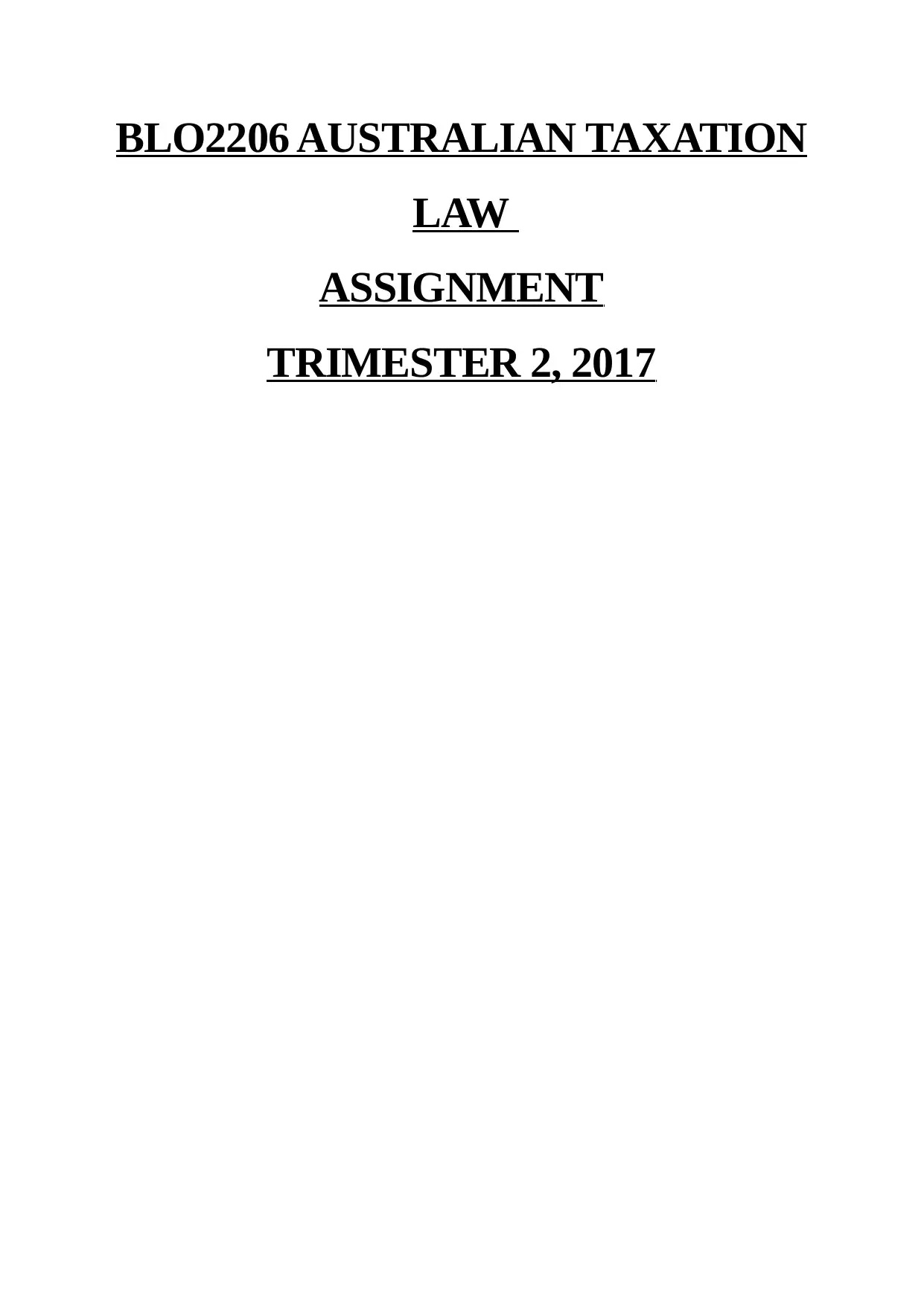
BLO2206 AUSTRALIAN TAXATION
LAW
ASSIGNMENT
TRIMESTER 2, 2017
LAW
ASSIGNMENT
TRIMESTER 2, 2017
Secure Best Marks with AI Grader
Need help grading? Try our AI Grader for instant feedback on your assignments.
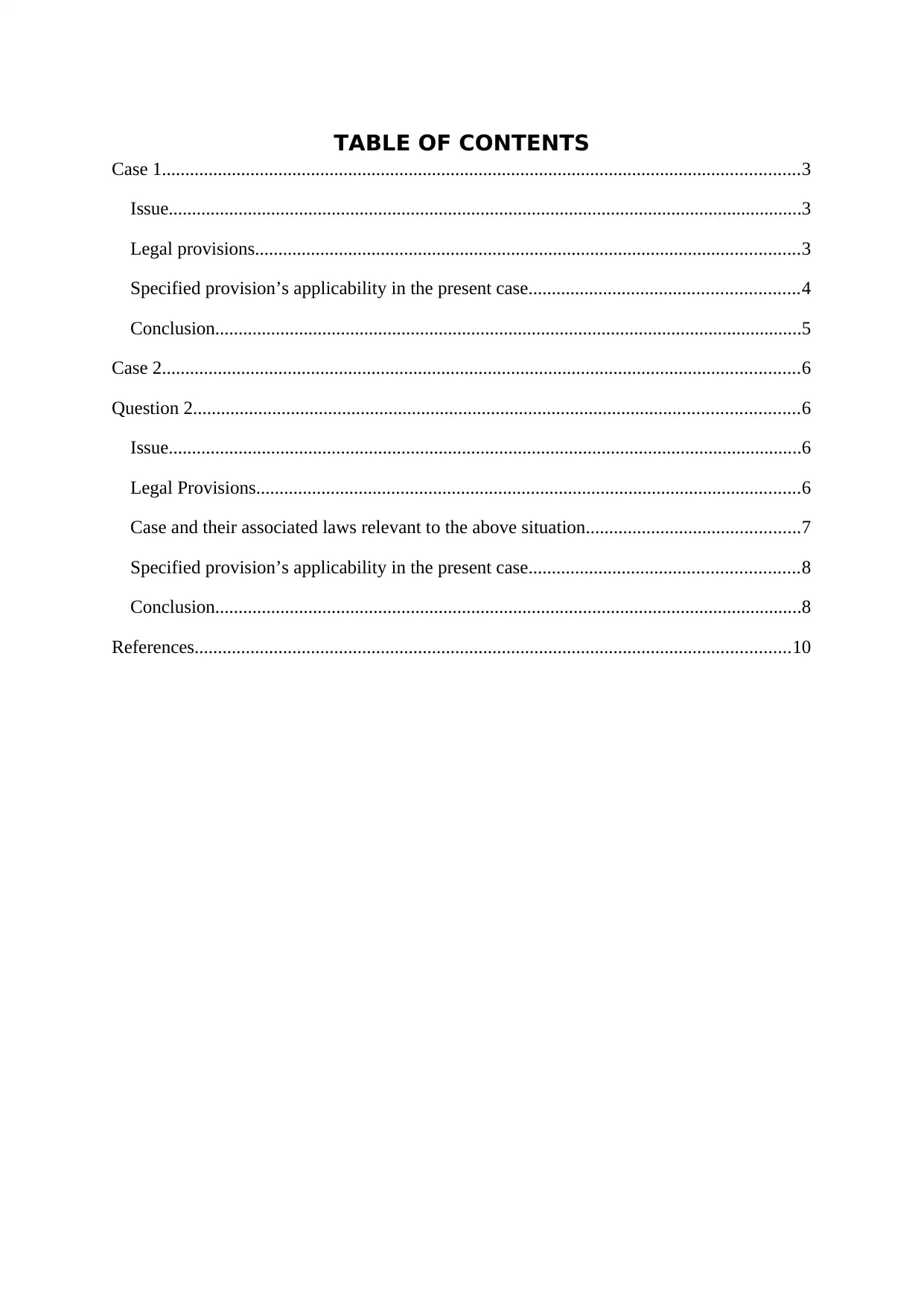
TABLE OF CONTENTS
Case 1.........................................................................................................................................3
Issue........................................................................................................................................3
Legal provisions.....................................................................................................................3
Specified provision’s applicability in the present case..........................................................4
Conclusion..............................................................................................................................5
Case 2.........................................................................................................................................6
Question 2..................................................................................................................................6
Issue........................................................................................................................................6
Legal Provisions.....................................................................................................................6
Case and their associated laws relevant to the above situation..............................................7
Specified provision’s applicability in the present case..........................................................8
Conclusion..............................................................................................................................8
References................................................................................................................................10
Case 1.........................................................................................................................................3
Issue........................................................................................................................................3
Legal provisions.....................................................................................................................3
Specified provision’s applicability in the present case..........................................................4
Conclusion..............................................................................................................................5
Case 2.........................................................................................................................................6
Question 2..................................................................................................................................6
Issue........................................................................................................................................6
Legal Provisions.....................................................................................................................6
Case and their associated laws relevant to the above situation..............................................7
Specified provision’s applicability in the present case..........................................................8
Conclusion..............................................................................................................................8
References................................................................................................................................10
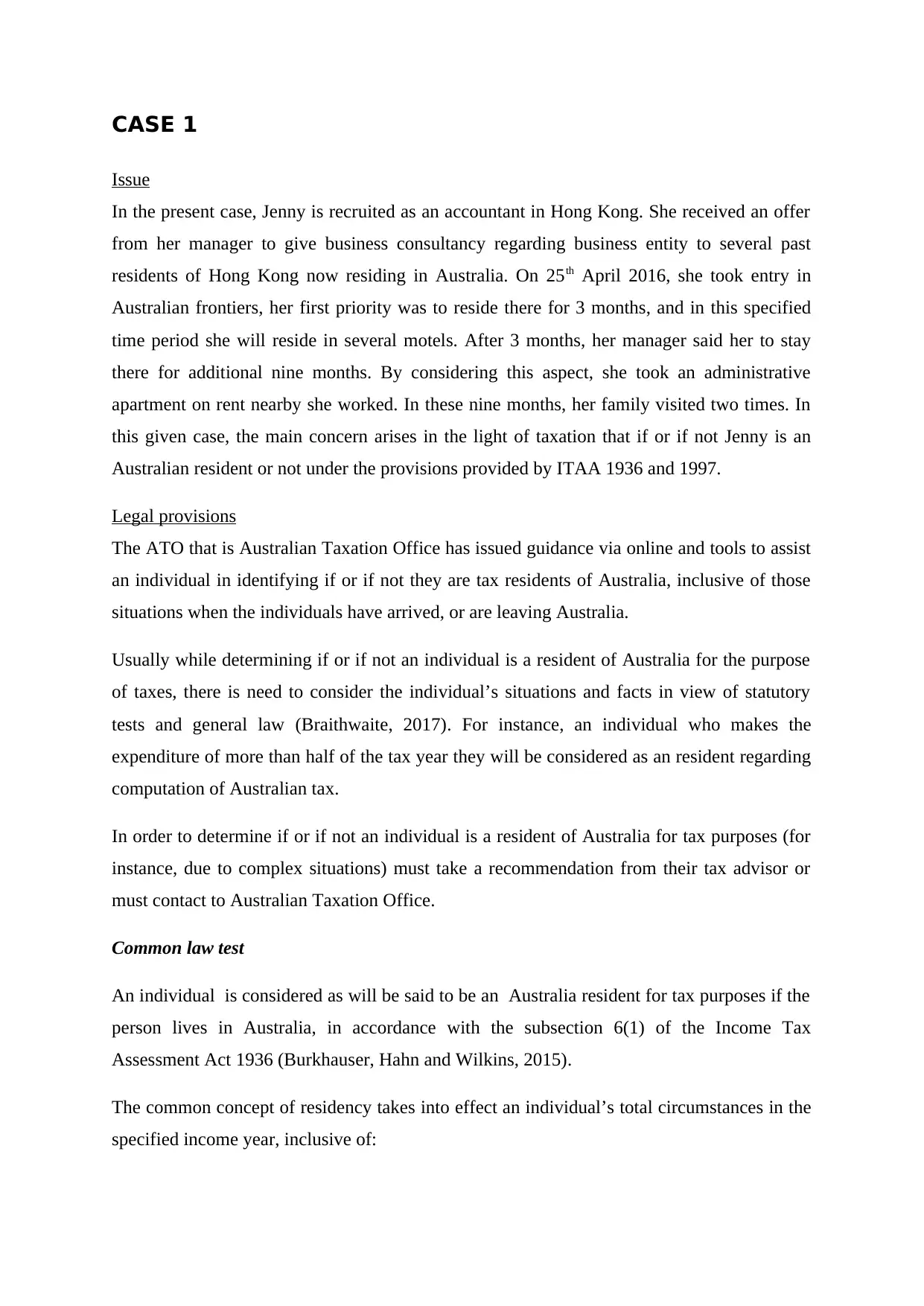
CASE 1
Issue
In the present case, Jenny is recruited as an accountant in Hong Kong. She received an offer
from her manager to give business consultancy regarding business entity to several past
residents of Hong Kong now residing in Australia. On 25th April 2016, she took entry in
Australian frontiers, her first priority was to reside there for 3 months, and in this specified
time period she will reside in several motels. After 3 months, her manager said her to stay
there for additional nine months. By considering this aspect, she took an administrative
apartment on rent nearby she worked. In these nine months, her family visited two times. In
this given case, the main concern arises in the light of taxation that if or if not Jenny is an
Australian resident or not under the provisions provided by ITAA 1936 and 1997.
Legal provisions
The ATO that is Australian Taxation Office has issued guidance via online and tools to assist
an individual in identifying if or if not they are tax residents of Australia, inclusive of those
situations when the individuals have arrived, or are leaving Australia.
Usually while determining if or if not an individual is a resident of Australia for the purpose
of taxes, there is need to consider the individual’s situations and facts in view of statutory
tests and general law (Braithwaite, 2017). For instance, an individual who makes the
expenditure of more than half of the tax year they will be considered as an resident regarding
computation of Australian tax.
In order to determine if or if not an individual is a resident of Australia for tax purposes (for
instance, due to complex situations) must take a recommendation from their tax advisor or
must contact to Australian Taxation Office.
Common law test
An individual is considered as will be said to be an Australia resident for tax purposes if the
person lives in Australia, in accordance with the subsection 6(1) of the Income Tax
Assessment Act 1936 (Burkhauser, Hahn and Wilkins, 2015).
The common concept of residency takes into effect an individual’s total circumstances in the
specified income year, inclusive of:
Issue
In the present case, Jenny is recruited as an accountant in Hong Kong. She received an offer
from her manager to give business consultancy regarding business entity to several past
residents of Hong Kong now residing in Australia. On 25th April 2016, she took entry in
Australian frontiers, her first priority was to reside there for 3 months, and in this specified
time period she will reside in several motels. After 3 months, her manager said her to stay
there for additional nine months. By considering this aspect, she took an administrative
apartment on rent nearby she worked. In these nine months, her family visited two times. In
this given case, the main concern arises in the light of taxation that if or if not Jenny is an
Australian resident or not under the provisions provided by ITAA 1936 and 1997.
Legal provisions
The ATO that is Australian Taxation Office has issued guidance via online and tools to assist
an individual in identifying if or if not they are tax residents of Australia, inclusive of those
situations when the individuals have arrived, or are leaving Australia.
Usually while determining if or if not an individual is a resident of Australia for the purpose
of taxes, there is need to consider the individual’s situations and facts in view of statutory
tests and general law (Braithwaite, 2017). For instance, an individual who makes the
expenditure of more than half of the tax year they will be considered as an resident regarding
computation of Australian tax.
In order to determine if or if not an individual is a resident of Australia for tax purposes (for
instance, due to complex situations) must take a recommendation from their tax advisor or
must contact to Australian Taxation Office.
Common law test
An individual is considered as will be said to be an Australia resident for tax purposes if the
person lives in Australia, in accordance with the subsection 6(1) of the Income Tax
Assessment Act 1936 (Burkhauser, Hahn and Wilkins, 2015).
The common concept of residency takes into effect an individual’s total circumstances in the
specified income year, inclusive of:
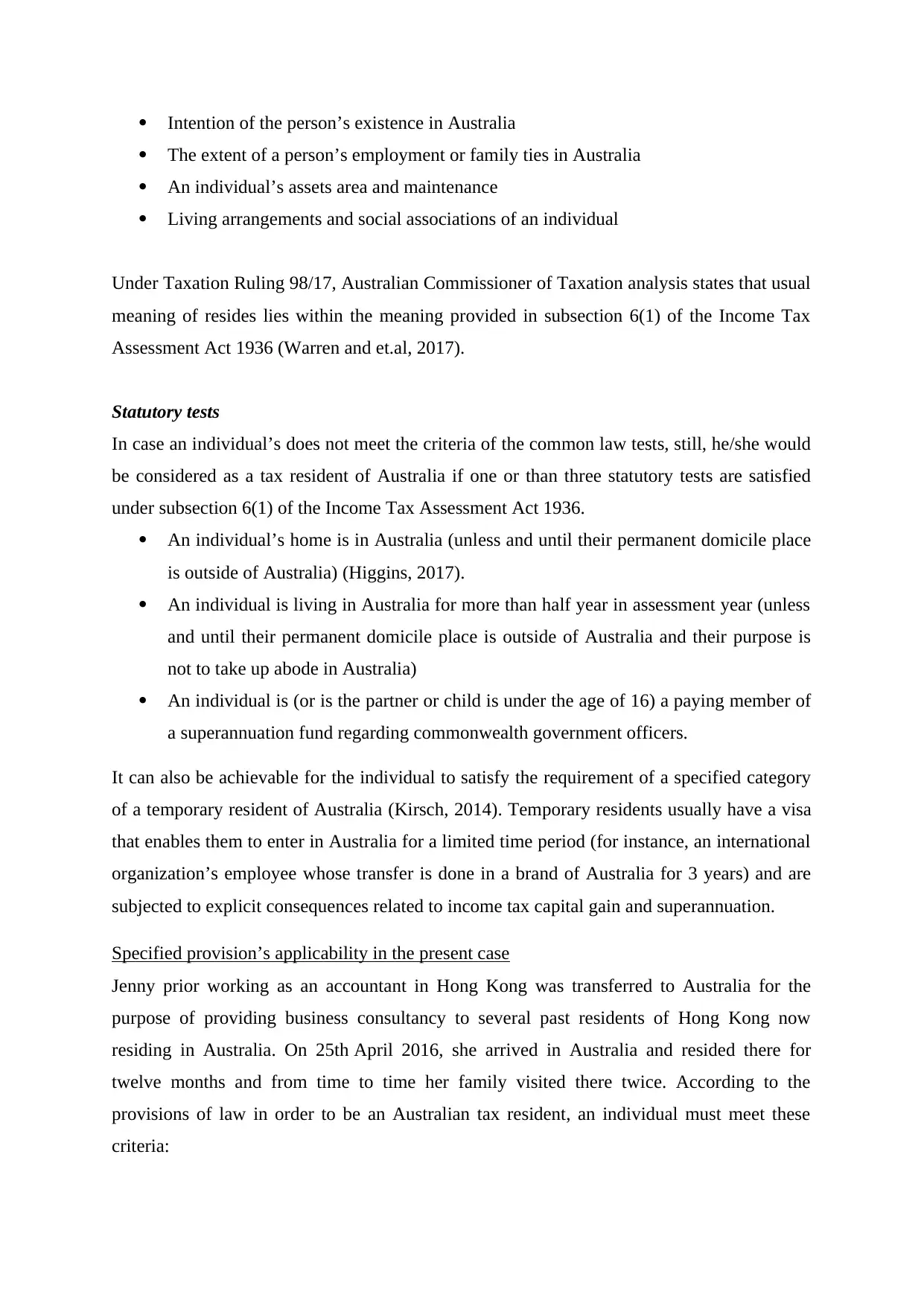
Intention of the person’s existence in Australia
The extent of a person’s employment or family ties in Australia
An individual’s assets area and maintenance
Living arrangements and social associations of an individual
Under Taxation Ruling 98/17, Australian Commissioner of Taxation analysis states that usual
meaning of resides lies within the meaning provided in subsection 6(1) of the Income Tax
Assessment Act 1936 (Warren and et.al, 2017).
Statutory tests
In case an individual’s does not meet the criteria of the common law tests, still, he/she would
be considered as a tax resident of Australia if one or than three statutory tests are satisfied
under subsection 6(1) of the Income Tax Assessment Act 1936.
An individual’s home is in Australia (unless and until their permanent domicile place
is outside of Australia) (Higgins, 2017).
An individual is living in Australia for more than half year in assessment year (unless
and until their permanent domicile place is outside of Australia and their purpose is
not to take up abode in Australia)
An individual is (or is the partner or child is under the age of 16) a paying member of
a superannuation fund regarding commonwealth government officers.
It can also be achievable for the individual to satisfy the requirement of a specified category
of a temporary resident of Australia (Kirsch, 2014). Temporary residents usually have a visa
that enables them to enter in Australia for a limited time period (for instance, an international
organization’s employee whose transfer is done in a brand of Australia for 3 years) and are
subjected to explicit consequences related to income tax capital gain and superannuation.
Specified provision’s applicability in the present case
Jenny prior working as an accountant in Hong Kong was transferred to Australia for the
purpose of providing business consultancy to several past residents of Hong Kong now
residing in Australia. On 25th April 2016, she arrived in Australia and resided there for
twelve months and from time to time her family visited there twice. According to the
provisions of law in order to be an Australian tax resident, an individual must meet these
criteria:
The extent of a person’s employment or family ties in Australia
An individual’s assets area and maintenance
Living arrangements and social associations of an individual
Under Taxation Ruling 98/17, Australian Commissioner of Taxation analysis states that usual
meaning of resides lies within the meaning provided in subsection 6(1) of the Income Tax
Assessment Act 1936 (Warren and et.al, 2017).
Statutory tests
In case an individual’s does not meet the criteria of the common law tests, still, he/she would
be considered as a tax resident of Australia if one or than three statutory tests are satisfied
under subsection 6(1) of the Income Tax Assessment Act 1936.
An individual’s home is in Australia (unless and until their permanent domicile place
is outside of Australia) (Higgins, 2017).
An individual is living in Australia for more than half year in assessment year (unless
and until their permanent domicile place is outside of Australia and their purpose is
not to take up abode in Australia)
An individual is (or is the partner or child is under the age of 16) a paying member of
a superannuation fund regarding commonwealth government officers.
It can also be achievable for the individual to satisfy the requirement of a specified category
of a temporary resident of Australia (Kirsch, 2014). Temporary residents usually have a visa
that enables them to enter in Australia for a limited time period (for instance, an international
organization’s employee whose transfer is done in a brand of Australia for 3 years) and are
subjected to explicit consequences related to income tax capital gain and superannuation.
Specified provision’s applicability in the present case
Jenny prior working as an accountant in Hong Kong was transferred to Australia for the
purpose of providing business consultancy to several past residents of Hong Kong now
residing in Australia. On 25th April 2016, she arrived in Australia and resided there for
twelve months and from time to time her family visited there twice. According to the
provisions of law in order to be an Australian tax resident, an individual must meet these
criteria:
Secure Best Marks with AI Grader
Need help grading? Try our AI Grader for instant feedback on your assignments.
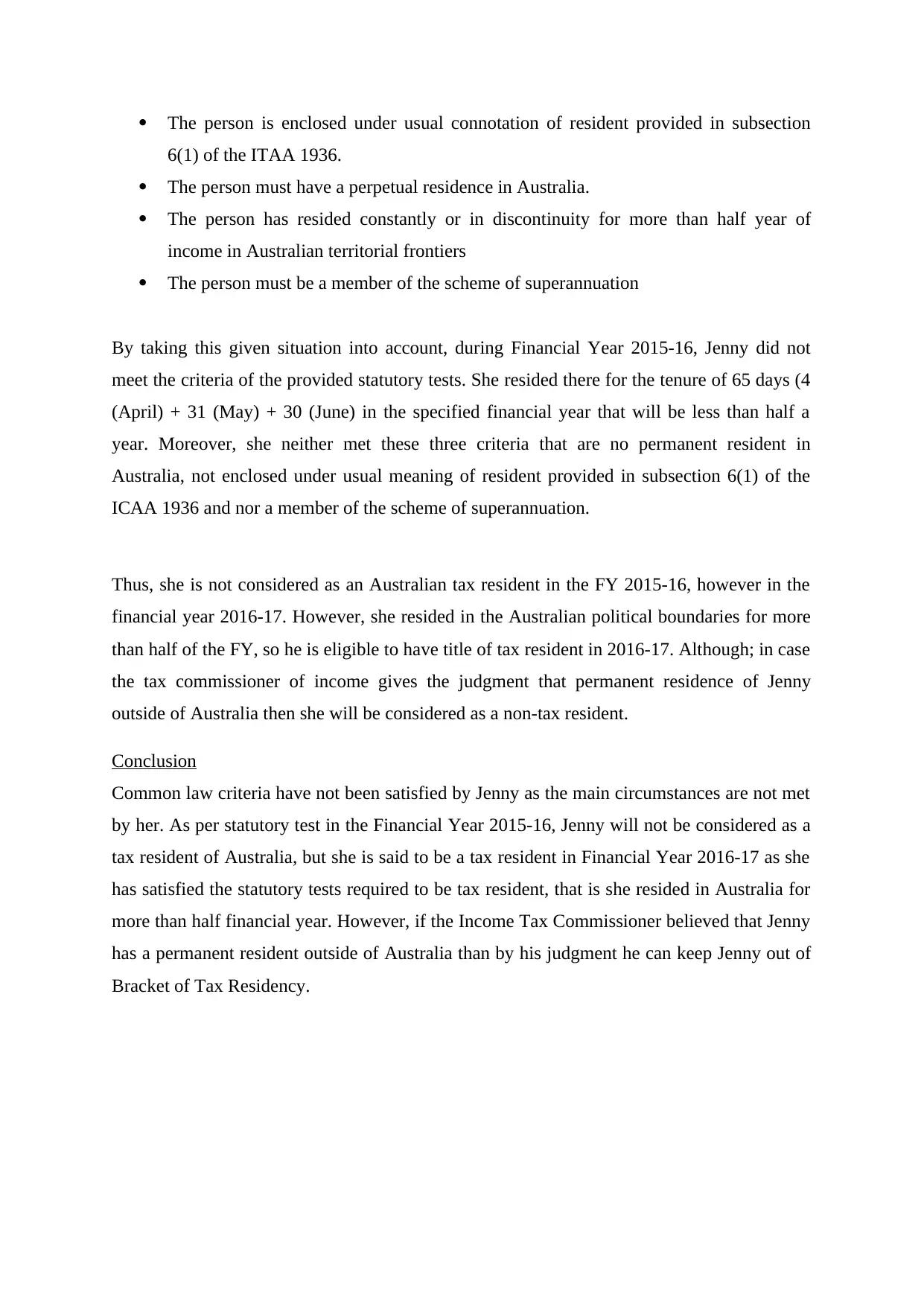
The person is enclosed under usual connotation of resident provided in subsection
6(1) of the ITAA 1936.
The person must have a perpetual residence in Australia.
The person has resided constantly or in discontinuity for more than half year of
income in Australian territorial frontiers
The person must be a member of the scheme of superannuation
By taking this given situation into account, during Financial Year 2015-16, Jenny did not
meet the criteria of the provided statutory tests. She resided there for the tenure of 65 days (4
(April) + 31 (May) + 30 (June) in the specified financial year that will be less than half a
year. Moreover, she neither met these three criteria that are no permanent resident in
Australia, not enclosed under usual meaning of resident provided in subsection 6(1) of the
ICAA 1936 and nor a member of the scheme of superannuation.
Thus, she is not considered as an Australian tax resident in the FY 2015-16, however in the
financial year 2016-17. However, she resided in the Australian political boundaries for more
than half of the FY, so he is eligible to have title of tax resident in 2016-17. Although; in case
the tax commissioner of income gives the judgment that permanent residence of Jenny
outside of Australia then she will be considered as a non-tax resident.
Conclusion
Common law criteria have not been satisfied by Jenny as the main circumstances are not met
by her. As per statutory test in the Financial Year 2015-16, Jenny will not be considered as a
tax resident of Australia, but she is said to be a tax resident in Financial Year 2016-17 as she
has satisfied the statutory tests required to be tax resident, that is she resided in Australia for
more than half financial year. However, if the Income Tax Commissioner believed that Jenny
has a permanent resident outside of Australia than by his judgment he can keep Jenny out of
Bracket of Tax Residency.
6(1) of the ITAA 1936.
The person must have a perpetual residence in Australia.
The person has resided constantly or in discontinuity for more than half year of
income in Australian territorial frontiers
The person must be a member of the scheme of superannuation
By taking this given situation into account, during Financial Year 2015-16, Jenny did not
meet the criteria of the provided statutory tests. She resided there for the tenure of 65 days (4
(April) + 31 (May) + 30 (June) in the specified financial year that will be less than half a
year. Moreover, she neither met these three criteria that are no permanent resident in
Australia, not enclosed under usual meaning of resident provided in subsection 6(1) of the
ICAA 1936 and nor a member of the scheme of superannuation.
Thus, she is not considered as an Australian tax resident in the FY 2015-16, however in the
financial year 2016-17. However, she resided in the Australian political boundaries for more
than half of the FY, so he is eligible to have title of tax resident in 2016-17. Although; in case
the tax commissioner of income gives the judgment that permanent residence of Jenny
outside of Australia then she will be considered as a non-tax resident.
Conclusion
Common law criteria have not been satisfied by Jenny as the main circumstances are not met
by her. As per statutory test in the Financial Year 2015-16, Jenny will not be considered as a
tax resident of Australia, but she is said to be a tax resident in Financial Year 2016-17 as she
has satisfied the statutory tests required to be tax resident, that is she resided in Australia for
more than half financial year. However, if the Income Tax Commissioner believed that Jenny
has a permanent resident outside of Australia than by his judgment he can keep Jenny out of
Bracket of Tax Residency.
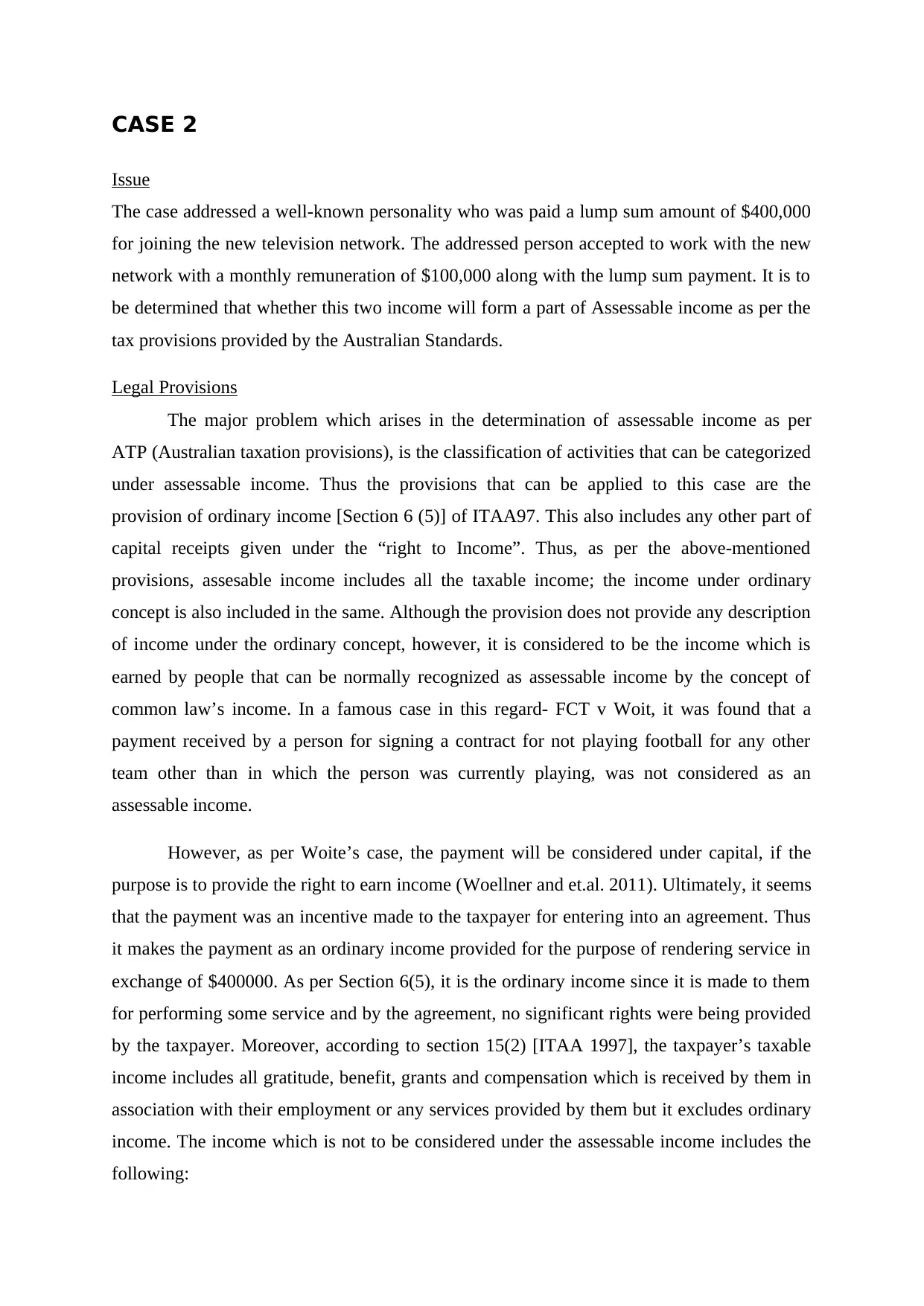
CASE 2
Issue
The case addressed a well-known personality who was paid a lump sum amount of $400,000
for joining the new television network. The addressed person accepted to work with the new
network with a monthly remuneration of $100,000 along with the lump sum payment. It is to
be determined that whether this two income will form a part of Assessable income as per the
tax provisions provided by the Australian Standards.
Legal Provisions
The major problem which arises in the determination of assessable income as per
ATP (Australian taxation provisions), is the classification of activities that can be categorized
under assessable income. Thus the provisions that can be applied to this case are the
provision of ordinary income [Section 6 (5)] of ITAA97. This also includes any other part of
capital receipts given under the “right to Income”. Thus, as per the above-mentioned
provisions, assesable income includes all the taxable income; the income under ordinary
concept is also included in the same. Although the provision does not provide any description
of income under the ordinary concept, however, it is considered to be the income which is
earned by people that can be normally recognized as assessable income by the concept of
common law’s income. In a famous case in this regard- FCT v Woit, it was found that a
payment received by a person for signing a contract for not playing football for any other
team other than in which the person was currently playing, was not considered as an
assessable income.
However, as per Woite’s case, the payment will be considered under capital, if the
purpose is to provide the right to earn income (Woellner and et.al. 2011). Ultimately, it seems
that the payment was an incentive made to the taxpayer for entering into an agreement. Thus
it makes the payment as an ordinary income provided for the purpose of rendering service in
exchange of $400000. As per Section 6(5), it is the ordinary income since it is made to them
for performing some service and by the agreement, no significant rights were being provided
by the taxpayer. Moreover, according to section 15(2) [ITAA 1997], the taxpayer’s taxable
income includes all gratitude, benefit, grants and compensation which is received by them in
association with their employment or any services provided by them but it excludes ordinary
income. The income which is not to be considered under the assessable income includes the
following:
Issue
The case addressed a well-known personality who was paid a lump sum amount of $400,000
for joining the new television network. The addressed person accepted to work with the new
network with a monthly remuneration of $100,000 along with the lump sum payment. It is to
be determined that whether this two income will form a part of Assessable income as per the
tax provisions provided by the Australian Standards.
Legal Provisions
The major problem which arises in the determination of assessable income as per
ATP (Australian taxation provisions), is the classification of activities that can be categorized
under assessable income. Thus the provisions that can be applied to this case are the
provision of ordinary income [Section 6 (5)] of ITAA97. This also includes any other part of
capital receipts given under the “right to Income”. Thus, as per the above-mentioned
provisions, assesable income includes all the taxable income; the income under ordinary
concept is also included in the same. Although the provision does not provide any description
of income under the ordinary concept, however, it is considered to be the income which is
earned by people that can be normally recognized as assessable income by the concept of
common law’s income. In a famous case in this regard- FCT v Woit, it was found that a
payment received by a person for signing a contract for not playing football for any other
team other than in which the person was currently playing, was not considered as an
assessable income.
However, as per Woite’s case, the payment will be considered under capital, if the
purpose is to provide the right to earn income (Woellner and et.al. 2011). Ultimately, it seems
that the payment was an incentive made to the taxpayer for entering into an agreement. Thus
it makes the payment as an ordinary income provided for the purpose of rendering service in
exchange of $400000. As per Section 6(5), it is the ordinary income since it is made to them
for performing some service and by the agreement, no significant rights were being provided
by the taxpayer. Moreover, according to section 15(2) [ITAA 1997], the taxpayer’s taxable
income includes all gratitude, benefit, grants and compensation which is received by them in
association with their employment or any services provided by them but it excludes ordinary
income. The income which is not to be considered under the assessable income includes the
following:
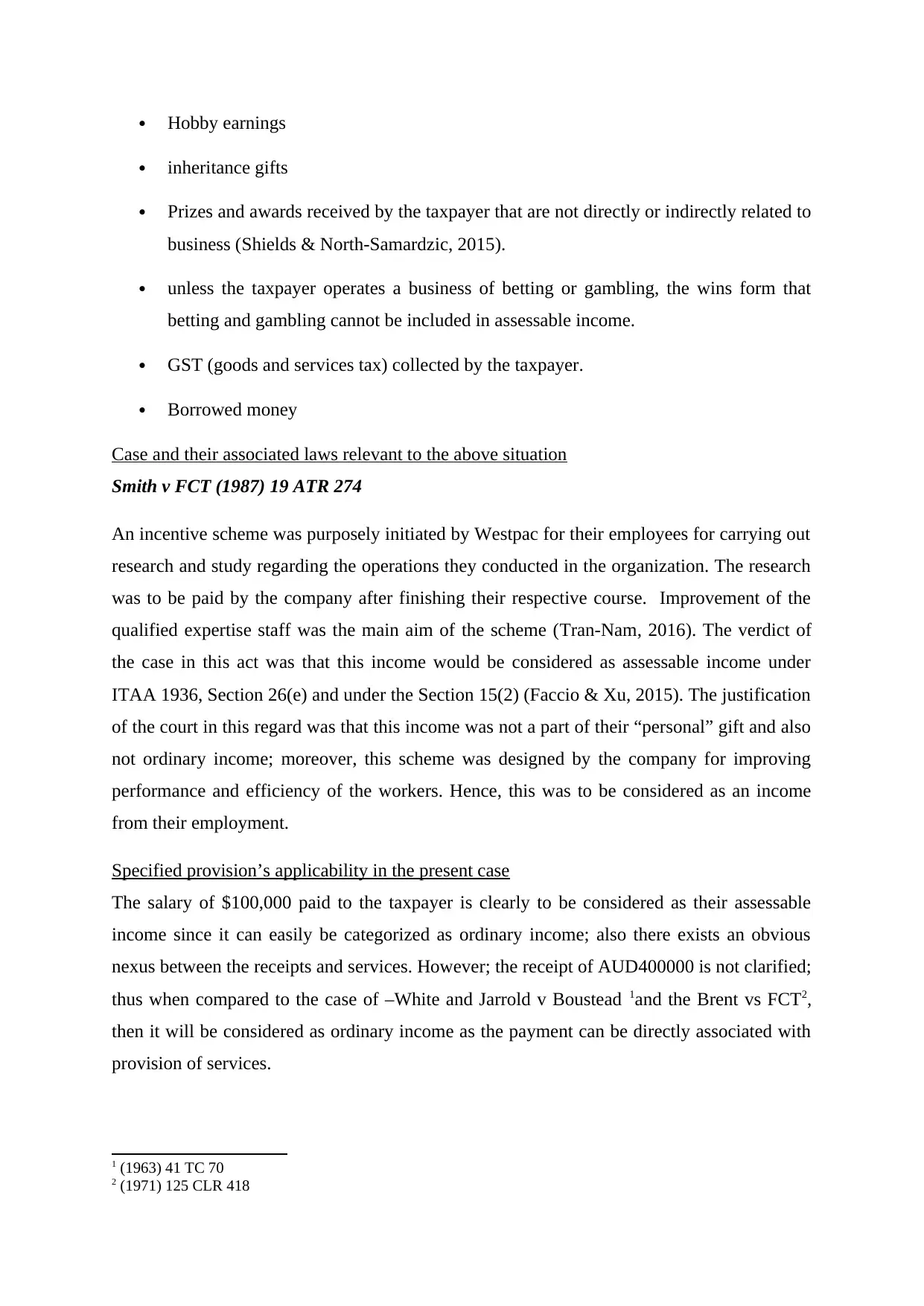
Hobby earnings
inheritance gifts
Prizes and awards received by the taxpayer that are not directly or indirectly related to
business (Shields & North-Samardzic, 2015).
unless the taxpayer operates a business of betting or gambling, the wins form that
betting and gambling cannot be included in assessable income.
GST (goods and services tax) collected by the taxpayer.
Borrowed money
Case and their associated laws relevant to the above situation
Smith v FCT (1987) 19 ATR 274
An incentive scheme was purposely initiated by Westpac for their employees for carrying out
research and study regarding the operations they conducted in the organization. The research
was to be paid by the company after finishing their respective course. Improvement of the
qualified expertise staff was the main aim of the scheme (Tran-Nam, 2016). The verdict of
the case in this act was that this income would be considered as assessable income under
ITAA 1936, Section 26(e) and under the Section 15(2) (Faccio & Xu, 2015). The justification
of the court in this regard was that this income was not a part of their “personal” gift and also
not ordinary income; moreover, this scheme was designed by the company for improving
performance and efficiency of the workers. Hence, this was to be considered as an income
from their employment.
Specified provision’s applicability in the present case
The salary of $100,000 paid to the taxpayer is clearly to be considered as their assessable
income since it can easily be categorized as ordinary income; also there exists an obvious
nexus between the receipts and services. However; the receipt of AUD400000 is not clarified;
thus when compared to the case of –White and Jarrold v Boustead 1and the Brent vs FCT2,
then it will be considered as ordinary income as the payment can be directly associated with
provision of services.
1 (1963) 41 TC 70
2 (1971) 125 CLR 418
inheritance gifts
Prizes and awards received by the taxpayer that are not directly or indirectly related to
business (Shields & North-Samardzic, 2015).
unless the taxpayer operates a business of betting or gambling, the wins form that
betting and gambling cannot be included in assessable income.
GST (goods and services tax) collected by the taxpayer.
Borrowed money
Case and their associated laws relevant to the above situation
Smith v FCT (1987) 19 ATR 274
An incentive scheme was purposely initiated by Westpac for their employees for carrying out
research and study regarding the operations they conducted in the organization. The research
was to be paid by the company after finishing their respective course. Improvement of the
qualified expertise staff was the main aim of the scheme (Tran-Nam, 2016). The verdict of
the case in this act was that this income would be considered as assessable income under
ITAA 1936, Section 26(e) and under the Section 15(2) (Faccio & Xu, 2015). The justification
of the court in this regard was that this income was not a part of their “personal” gift and also
not ordinary income; moreover, this scheme was designed by the company for improving
performance and efficiency of the workers. Hence, this was to be considered as an income
from their employment.
Specified provision’s applicability in the present case
The salary of $100,000 paid to the taxpayer is clearly to be considered as their assessable
income since it can easily be categorized as ordinary income; also there exists an obvious
nexus between the receipts and services. However; the receipt of AUD400000 is not clarified;
thus when compared to the case of –White and Jarrold v Boustead 1and the Brent vs FCT2,
then it will be considered as ordinary income as the payment can be directly associated with
provision of services.
1 (1963) 41 TC 70
2 (1971) 125 CLR 418
Paraphrase This Document
Need a fresh take? Get an instant paraphrase of this document with our AI Paraphraser
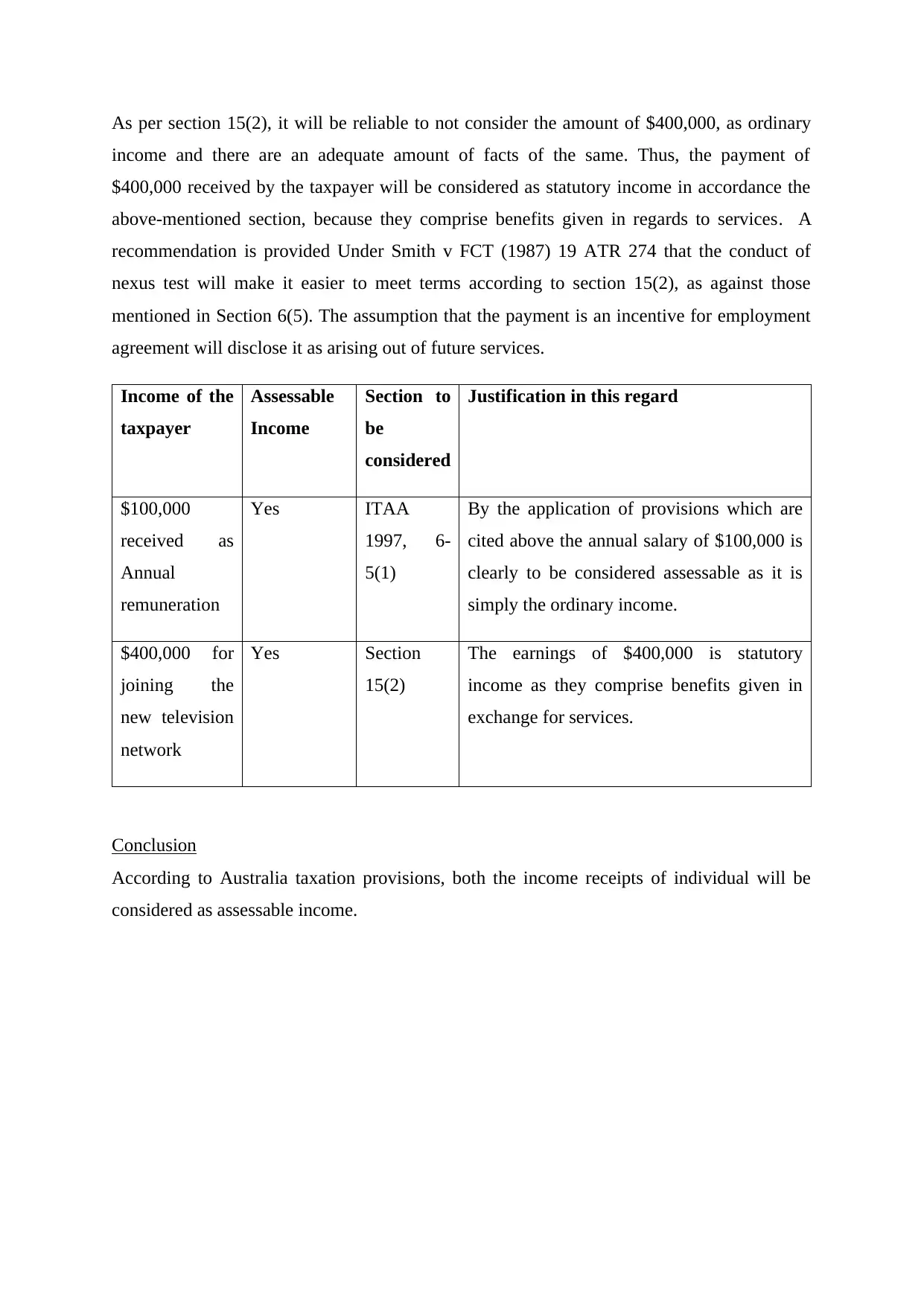
As per section 15(2), it will be reliable to not consider the amount of $400,000, as ordinary
income and there are an adequate amount of facts of the same. Thus, the payment of
$400,000 received by the taxpayer will be considered as statutory income in accordance the
above-mentioned section, because they comprise benefits given in regards to services. A
recommendation is provided Under Smith v FCT (1987) 19 ATR 274 that the conduct of
nexus test will make it easier to meet terms according to section 15(2), as against those
mentioned in Section 6(5). The assumption that the payment is an incentive for employment
agreement will disclose it as arising out of future services.
Income of the
taxpayer
Assessable
Income
Section to
be
considered
Justification in this regard
$100,000
received as
Annual
remuneration
Yes ITAA
1997, 6-
5(1)
By the application of provisions which are
cited above the annual salary of $100,000 is
clearly to be considered assessable as it is
simply the ordinary income.
$400,000 for
joining the
new television
network
Yes Section
15(2)
The earnings of $400,000 is statutory
income as they comprise benefits given in
exchange for services.
Conclusion
According to Australia taxation provisions, both the income receipts of individual will be
considered as assessable income.
income and there are an adequate amount of facts of the same. Thus, the payment of
$400,000 received by the taxpayer will be considered as statutory income in accordance the
above-mentioned section, because they comprise benefits given in regards to services. A
recommendation is provided Under Smith v FCT (1987) 19 ATR 274 that the conduct of
nexus test will make it easier to meet terms according to section 15(2), as against those
mentioned in Section 6(5). The assumption that the payment is an incentive for employment
agreement will disclose it as arising out of future services.
Income of the
taxpayer
Assessable
Income
Section to
be
considered
Justification in this regard
$100,000
received as
Annual
remuneration
Yes ITAA
1997, 6-
5(1)
By the application of provisions which are
cited above the annual salary of $100,000 is
clearly to be considered assessable as it is
simply the ordinary income.
$400,000 for
joining the
new television
network
Yes Section
15(2)
The earnings of $400,000 is statutory
income as they comprise benefits given in
exchange for services.
Conclusion
According to Australia taxation provisions, both the income receipts of individual will be
considered as assessable income.
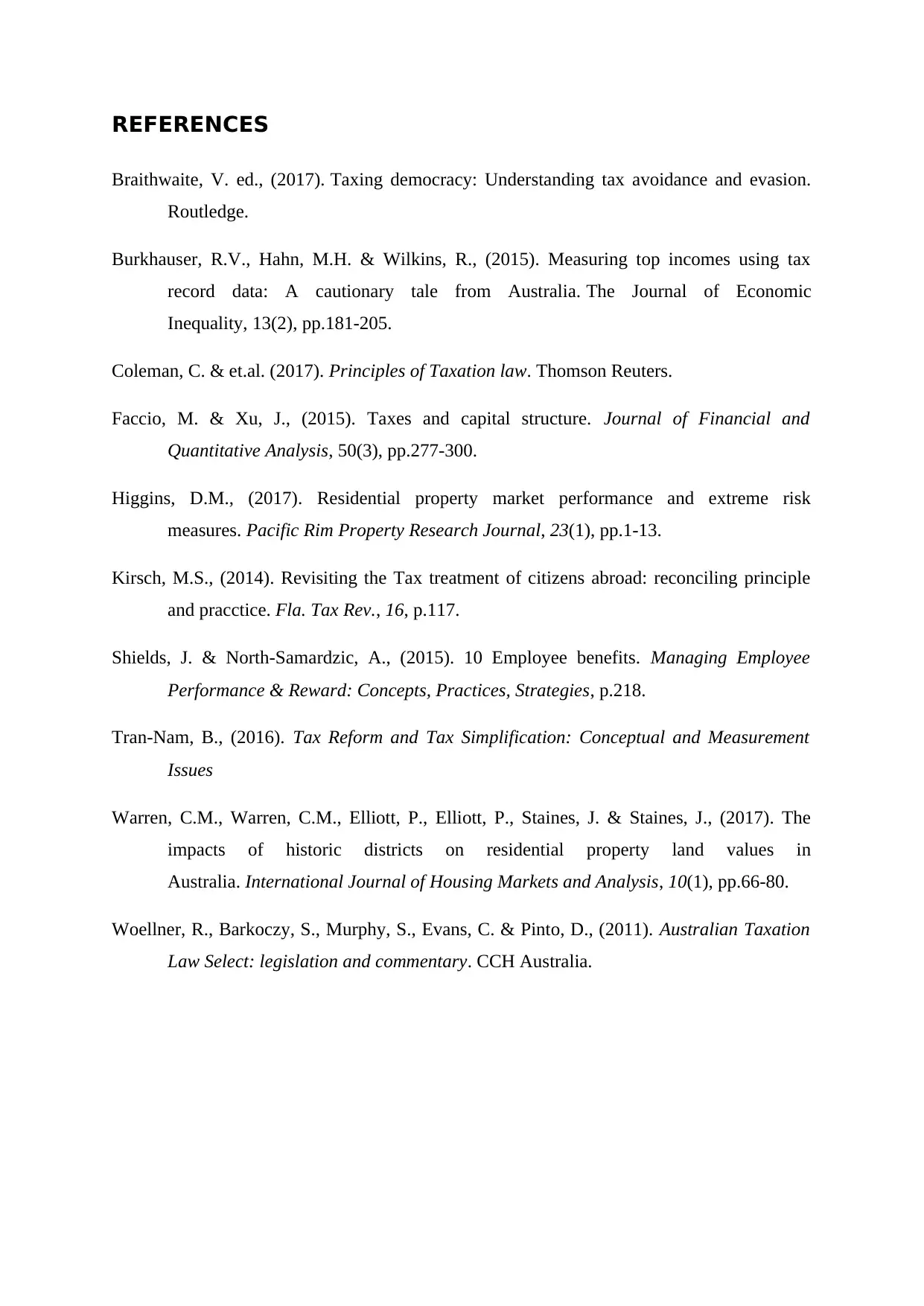
REFERENCES
Braithwaite, V. ed., (2017). Taxing democracy: Understanding tax avoidance and evasion.
Routledge.
Burkhauser, R.V., Hahn, M.H. & Wilkins, R., (2015). Measuring top incomes using tax
record data: A cautionary tale from Australia. The Journal of Economic
Inequality, 13(2), pp.181-205.
Coleman, C. & et.al. (2017). Principles of Taxation law. Thomson Reuters.
Faccio, M. & Xu, J., (2015). Taxes and capital structure. Journal of Financial and
Quantitative Analysis, 50(3), pp.277-300.
Higgins, D.M., (2017). Residential property market performance and extreme risk
measures. Pacific Rim Property Research Journal, 23(1), pp.1-13.
Kirsch, M.S., (2014). Revisiting the Tax treatment of citizens abroad: reconciling principle
and pracctice. Fla. Tax Rev., 16, p.117.
Shields, J. & North-Samardzic, A., (2015). 10 Employee benefits. Managing Employee
Performance & Reward: Concepts, Practices, Strategies, p.218.
Tran-Nam, B., (2016). Tax Reform and Tax Simplification: Conceptual and Measurement
Issues
Warren, C.M., Warren, C.M., Elliott, P., Elliott, P., Staines, J. & Staines, J., (2017). The
impacts of historic districts on residential property land values in
Australia. International Journal of Housing Markets and Analysis, 10(1), pp.66-80.
Woellner, R., Barkoczy, S., Murphy, S., Evans, C. & Pinto, D., (2011). Australian Taxation
Law Select: legislation and commentary. CCH Australia.
Braithwaite, V. ed., (2017). Taxing democracy: Understanding tax avoidance and evasion.
Routledge.
Burkhauser, R.V., Hahn, M.H. & Wilkins, R., (2015). Measuring top incomes using tax
record data: A cautionary tale from Australia. The Journal of Economic
Inequality, 13(2), pp.181-205.
Coleman, C. & et.al. (2017). Principles of Taxation law. Thomson Reuters.
Faccio, M. & Xu, J., (2015). Taxes and capital structure. Journal of Financial and
Quantitative Analysis, 50(3), pp.277-300.
Higgins, D.M., (2017). Residential property market performance and extreme risk
measures. Pacific Rim Property Research Journal, 23(1), pp.1-13.
Kirsch, M.S., (2014). Revisiting the Tax treatment of citizens abroad: reconciling principle
and pracctice. Fla. Tax Rev., 16, p.117.
Shields, J. & North-Samardzic, A., (2015). 10 Employee benefits. Managing Employee
Performance & Reward: Concepts, Practices, Strategies, p.218.
Tran-Nam, B., (2016). Tax Reform and Tax Simplification: Conceptual and Measurement
Issues
Warren, C.M., Warren, C.M., Elliott, P., Elliott, P., Staines, J. & Staines, J., (2017). The
impacts of historic districts on residential property land values in
Australia. International Journal of Housing Markets and Analysis, 10(1), pp.66-80.
Woellner, R., Barkoczy, S., Murphy, S., Evans, C. & Pinto, D., (2011). Australian Taxation
Law Select: legislation and commentary. CCH Australia.

1 out of 10
Related Documents
Your All-in-One AI-Powered Toolkit for Academic Success.
+13062052269
info@desklib.com
Available 24*7 on WhatsApp / Email
![[object Object]](/_next/static/media/star-bottom.7253800d.svg)
Unlock your academic potential
© 2024 | Zucol Services PVT LTD | All rights reserved.





